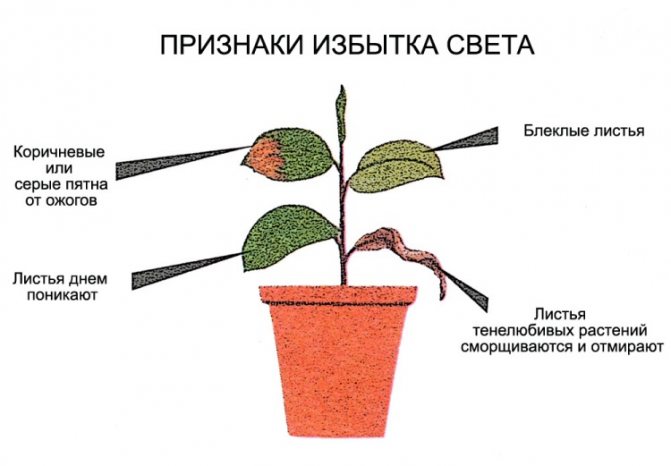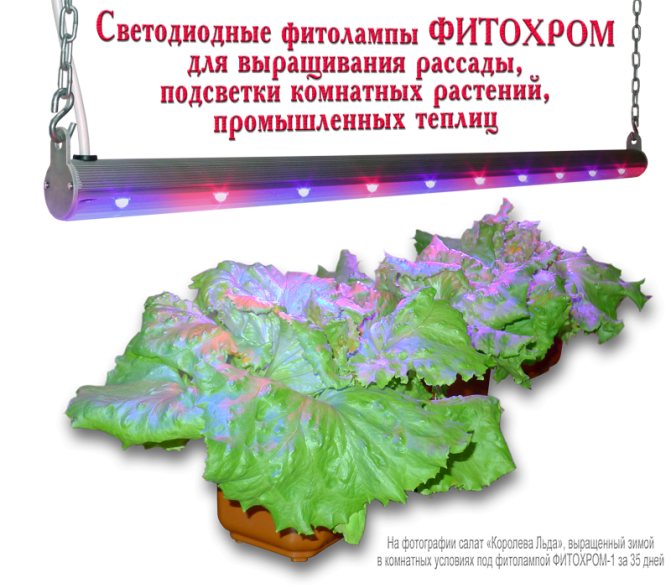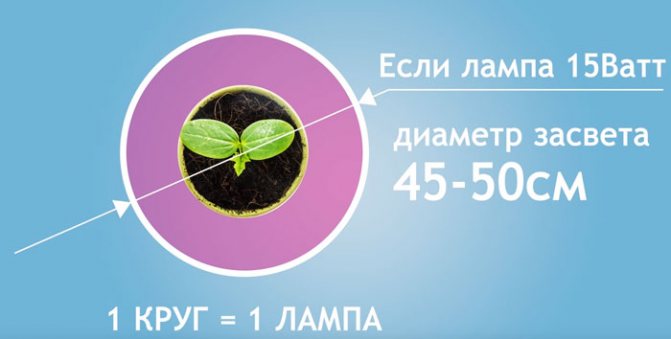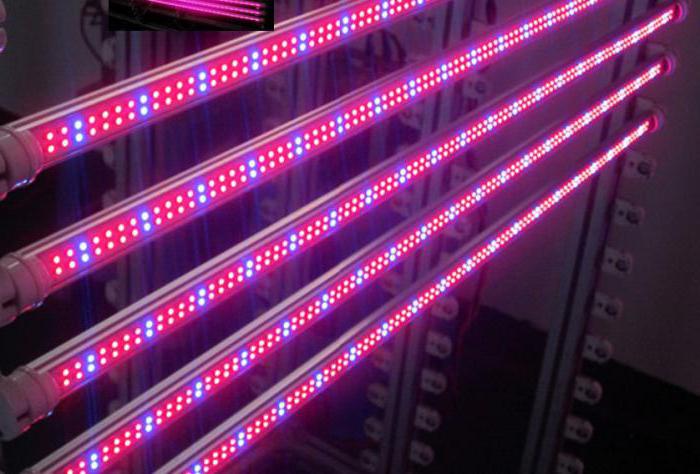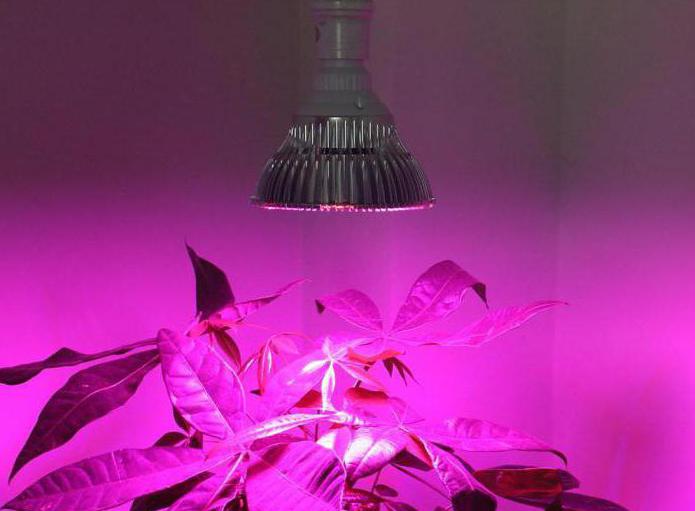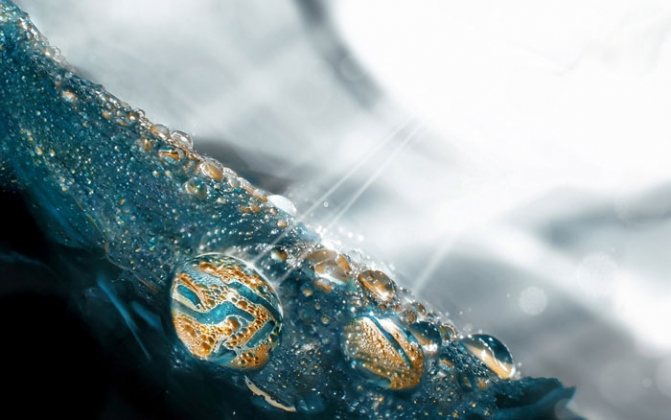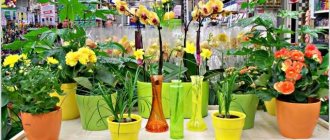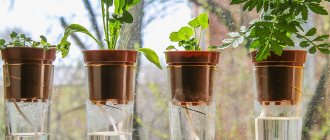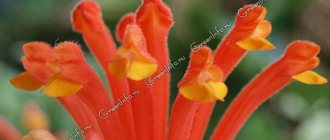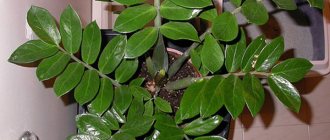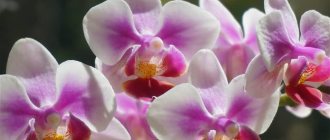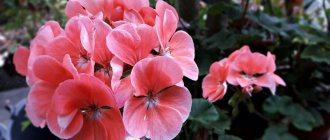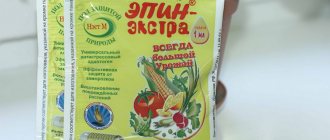How and why to use them? Why ordinary lamps are not suitable for plants
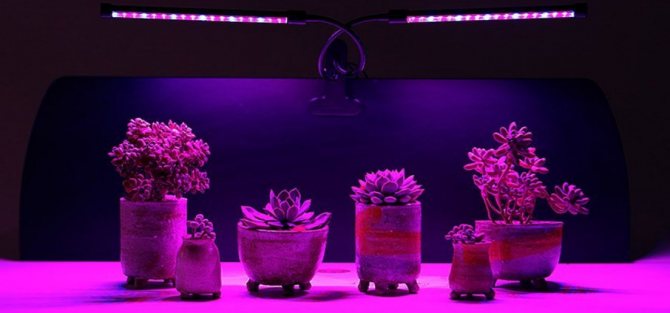
For the growth of any plant, including indoor plants, light is important, which is necessary for photosynthesis - the process of synthesizing carbohydrates as energy sources for growth. In the winter months, when there is not enough natural sunlight, when the daylight hours are too short, indoor plants are in great need of additional lighting. The challenge is to provide a light spectrum similar to that of the sun, or to provide a spectrum that is more suited to the needs of a particular cultivated species.
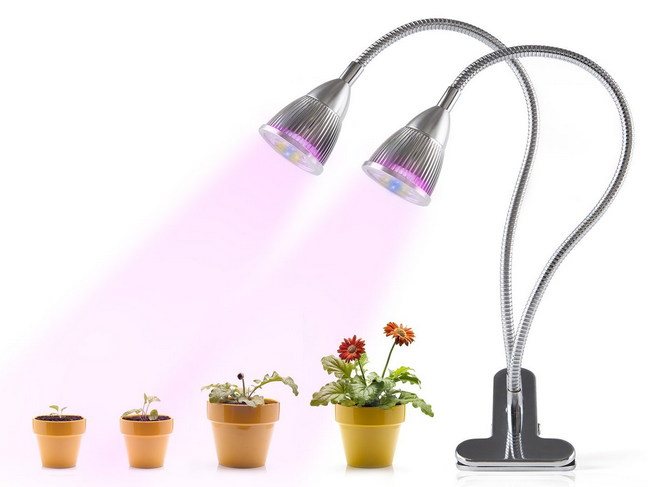

Depending on the type of cultivated plant, the stage of cultivation (germination / vegetative phase or flowering / fruiting phase) and the photoperiod required by the plants, specific spectral ranges, luminous efficiency and color temperature are selected.
The first to use artificial light for plant cultivation and scientific research was the Russian botanist Andrei Famintsyn (1868).
Plants are affected by the amount of light received, its intensity; light color; duration of additional lighting.
- Everything for plants
Many people supplement the illumination of plants with ordinary lamps, but this does not help, winter shoots still stretch out and remain pale and thin. The fact is that not every artificial light reaches the intensity of daylight. Moreover, the distance from the light source to the plants is also important.
Phytolamps are different from conventional lamps. Plants love them more than other artificial lighting sources.
The illumination intensity of the lamps is indicated on the packaging (LC per m2).
For the minimum photosynthetic activity of the plant, an illumination level of 100 lux (lux) is needed, but for the normal assimilation of carbon dioxide, water and other substances, a level of at least 1000 lux is needed. On a cloudy winter day, an illumination of 100 lux is the light on the sill of the south window, but an illumination of 1000 lux is on the same day outdoors, not indoors.
Some plants require direct sunlight, others require bright, diffused lighting, and some thrive in partial shade.
There is not enough natural light to grow berries (strawberries) and vegetables indoors.
If you give the plant too much sun, it will look bleached, pale, or burnt; if there are too few hours, it will have thin leaves and elongated shoots. Some plants require about half a day of light per day, others need 18 hours of light every day; the latter include vegetables
that will turn pale without enough light. However, others such as
violets
, you only need about eight hours of light a day all year round
Cacti, for example, need a lot of light, which we do not have in winter, which is why it is advisable to send them to hibernation in winter (with a low temperature and almost no watering).
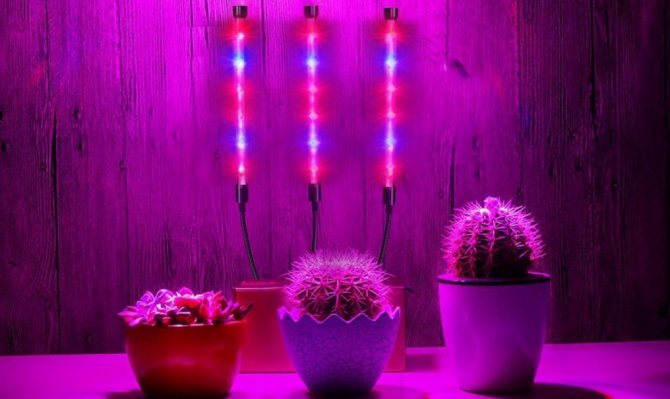

Basically, all our indoor plants come from latitudes, where daylight hours averages 12 hours a day, and the light intensity practically does not change with the change of seasons and reaches 120,000 lux. It can be very difficult for them in our apartments.
In winter, it is desirable to provide the plants with the following supplementary lighting modes:
- Partial shade plants: 1000-3000 lux, it is enough to stay on the windowsill, additional lighting is needed only if you are in the back of the room.
- Plants preferring diffused light: 3000-4000 lux.
- Plants requiring direct sun: 4000-6000 lux.
- Exotic and fruiting: 6000-12000 lux.
Group the plants for the winter according to their supplementary lighting requirements.
Artificial light must fall on the plants in the same way as natural light - from above, otherwise the plants will have to expend energy to change the position of the leaves in order to get as much light as possible. It is due to the incorrect location of the light source (for example, from the side) that the stems of plants are bent.
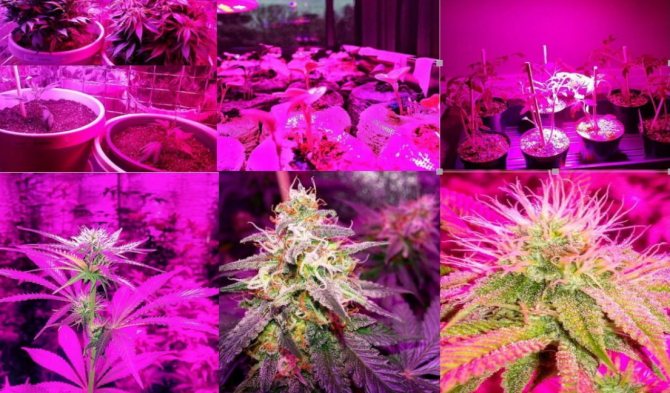

Distance
Violets can be very close to the light source, and the philodendron can be located in place. But vegetables need a much higher light intensity to produce a crop.
Daylight hours should not exceed 12 hours per day for adult plants, otherwise you can disrupt the development of flower buds, the plant will not bloom and bear fruit (fruits and vegetables are a separate topic, they need more).
But young seedlings need round-the-clock lighting. In the first days after germination, young seedlings can be provided with 24-hour bright lighting. Then daylight hours are gradually reduced to 16 and later to 14 hours a day.
Heat-loving tropical plants hibernate with a slight decrease in temperature and illumination. For other plants, a decrease in illumination is allowed only during a cool wintering (5-15 degrees C). In the dark and cold (0-5 degrees C), only deciduous plants are allowed.
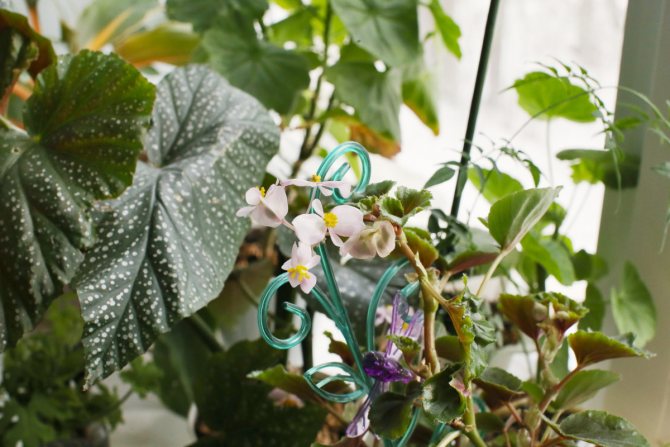

What is phytolamp
Seedlings are grown at home or in greenhouses. In two versions, the use of phytolamps is required. This is a special UV light that can completely replace natural light. Application is especially in demand in winter, when the daylight hours are short and mostly cloudy.
Phytolamp differs from conventional lamps in its color spectrum. Our eye perceives a white, yellow glow. And plants need a blue, red spectrum. At the same time, the process of photosynthesis is better (the seedlings are gaining growth, the stem and root system are strengthened).
Varieties of products
Lamps in their variety can be fluorescent and LED. In terms of the quality of radiation, it is the last version of lamps for plants that is considered stronger. It is customary to install an LED lamp in greenhouses, since it consumes very little electricity. You can use this phytolight for more than 50 thousand hours. The LED backlight does not heat up much, so it cannot harm the plant leaves.
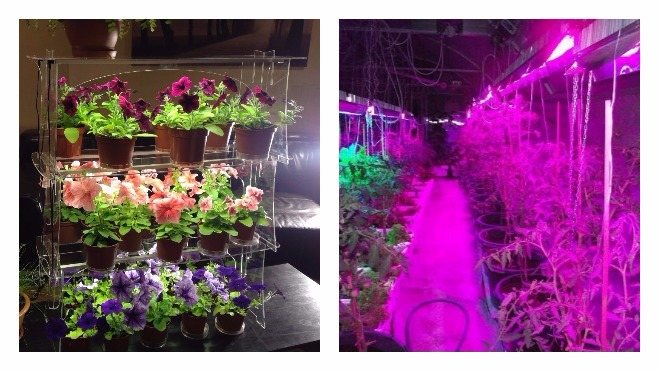

The lamps are very durable as they do not have filament in their construction. They do not emit harmful rays, therefore they are harmless to both humans and any other living organism. They do not flicker, do not spoil your eyesight.
Luminaires are manufactured with various mountings. They can be suspended from the ceiling, while their height will be adjustable. For correct illumination, you can choose the angle of inclination and brightness of the illumination, and the radiation power is in the range of 20-300 watts.
The phytolamp can be classified as the best gardener's tools.
With its help, flowers and other plants can be grown for a whole year. It will allow you to wait for the harvest of vegetables and fruits. You can buy such a device in a lighting or zootechnical company.
The OSRAM FLUORA phytolamp is considered to be one of the most popular types of luminaires. Its price reaches $ 5, depending on its course. You can buy such a lamp for indoor plants in almost any store. Its positive aspects include the following characteristics:
- low price;
- reliability;
- excellent color spectrum.
But the service life of this lamp is only 24 months, then the light intensity is reduced.
The less popular are luminescent models:
- OSRAM Sylvania;
- Sylvania Grolux
- all kinds of lamps and lamps Philips, Hagen Flora-Glo, which are designed for the aquarium.
Externally, it will not be possible to distinguish between LED phytolamps for plants and LED Grow Light. They are red, blue and vary in power. If a person buys a non-Chinese lamp, a certificate must be attached to it.
Principle of operation
The phytolamp uses linear phytolamps, LEDs and electronic control microcircuits. Power converters help to achieve a variety of colors. So the glow of a blue shade promotes the development of the root system, the growth of leaves, red - the development, increased flowering.
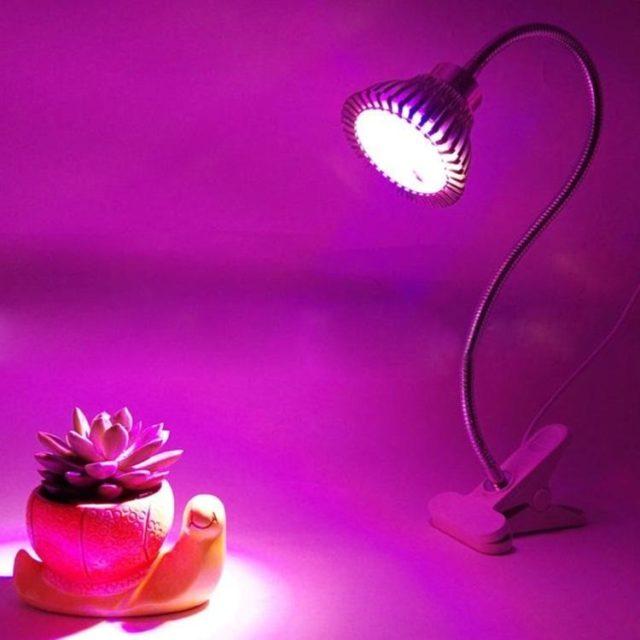

In lamps, the light sources are adjusted so that these colors prevail. To a person, such a glow seems purple-pink.
Influence of the spectrum segment on vegetation
How does the spectrum of light affect the plant:
- blue rays - normalize the formation of the crown and roots;
- red - help the seeds to hatch, strengthen the stems and activate flowering;
- green, yellow (+ derivatives) - have a general positive effect;
- ultraviolet and infrared rays are not created by phytolamps, since their influence cannot be called exclusively positive.
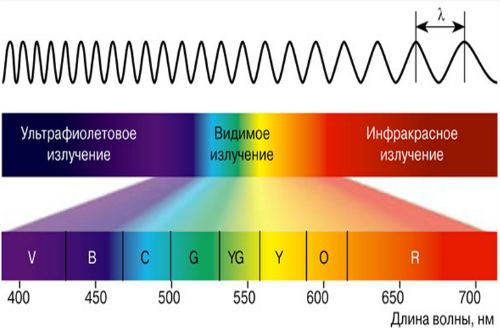

Pluses of phytolamps for plants
The use of phytolamps for growing plants is due to a number of advantages:
- the light does not spread throughout the room, but is directed at the seedling;
- LED bulbs consume a small amount of energy compared to incandescent bulbs;
- operation for 50,000 hours without losing the quality of the luminous flux;
- the most effective way of lighting, ensuring the full development of sprouts;
- does not radiate heat, that is, there will be no overheating and burning in plants, the distance may be minimal;
- ease of use (changing bulbs does not require special skills);
- phytolamps are the most environmentally friendly, they do not contain substances hazardous to health and the environment;
- adjustment of light saturation;
- no flicker;
- non-explosive;
- the spectrum of colors does not contain ultraviolet radiation, which is dangerous for sprouts;
- due to complete sealing, it is possible to use in rooms with high humidity.
The main point is to choose the right device, to install phytolight above the plant.
How to build a device with your own hands
It is not necessary to buy plant lamps in the store, you can build them yourself. The device can be made from LED strip, which is sold in almost every electrical store. It is important to know that a do-it-yourself phytolamp for plants is affordable.
You can attach such a tape to any surface.
Since the LED lamp is made by hand, there is an opportunity to choose a design yourself and make it unique. Elements can be added to this design that will be responsible for the diffusion of the light beam and the direction of the light. Usually LED strips are 8-10 mm wide. The more powerful the diodes, the wider the product will be for plants. It is important to know that such a fluorescent lamp works from 15 V. If there is no such voltage in the room, you should additionally purchase an adapter.
Types of phytolamps
Phytolamps for plant illumination at home are divided into types:
- Gas-discharge sodium. Such lamps spread light in all directions, which is not very convenient for home use. If, nevertheless, installation will be carried out in houses, then reflectors must be used. The downside is that the surface heats up, you need to monitor the level of the installation.


It is inadmissible to get water on a working lamp. This will cause the source to rupture.
- Metal halide.The flask contains halogen vapor. The glow is produced in green and yellow-orange shades. The blue spectrum is not clearly expressed, but its amount is sufficient. This glow is especially good for growing plants in the early stages of development. Such a lamp contributes to the correct formation of the root system. The species is demanding on voltage stability.
- Mercury gas discharge source. No additional hardware required. The flask has a mirror coating, which forms a stream of light in the direction of the seedlings. It emits a lot of the red spectrum. This is not bad, as it is needed for photosynthesis. The use of such sources can replace the full radiation of the sun. Full work takes place with constant voltage supply.
- Fluorescent - a type of gas-discharge lamps. For plants, you need to buy a variety of phyto or an ordinary lamp with a spectrum of 6400K. Fito can be with a pin or regular base. Linear distribution requires a starting device. Safe source with low energy consumption. For full lighting, you will need two or more bulbs.
- LED phytolamp. You can buy both crystals individually and a tape of the required power. It should be borne in mind that the red range prevails in the ribbon, which is responsible for growth and flowering, and the root system needs a blue range. Therefore, you need to additionally buy a blue strip and add to the photo LEDs. The advantages are that when using tapes of different luminescence spectrum, you can independently assemble the desired lamp.
conclusions
- The most convenient for growing seedlings on the windowsill and for indoor flowers can be considered linear LED phytolamps bicolor or full spectrum lighting
- Multispectrum lamps are good for stimulating flowering and fruiting of capricious indoor plants.
- To choose a lamp for Aliexpress, it is enough to know its power and the distance from the lamp to the plants (see the table above). However, it should be noted that the operating power of the lamp will be approximately half that declared by the manufacturer.
Terms of use
Growing, developing plants need regular lighting. At the first shoots, lighting is required around the clock. After that, there is a decrease and a transition to a normal daylight hours.
At home, proper installation of sources is required. If the plant light is made of LEDs, then it can be positioned at any distance from the plant. It will not heat up and will not harm.
Reflectors are used to adjust the direction of light. If there are no special lamps and fixtures, you can use foil.
When using a light apparatus, it is necessary to monitor the growth and development of the plant. If there is an overabundance, then the leaves will curl up, closing off the flow of light. If the stem has gone up and is not compacted, then it is necessary to increase the lighting hours or power.
We recommend watching the video:
How long does it take to highlight
The duration of the backlight depends on the crop and the weather. If the days are cloudy and short, the backlighting time will increase. Also, the duration depends on the age of the seedlings. If she just ascended, then round-the-clock lighting is required, then follow the regime.
If the plant begins to fold its leaves, then it requires rest, the light can be extinguished.
When processing seedlings and transplanting, a period of adaptation is expected, accompanied by a decrease in the supply of light.
Main characteristics of plant lamps
Each plant has a distinct internal stem and leaf structure. For their full development, an individual approach to lighting is required.
Orchids
An orchid lamp should contain blue, red, white luminous flux ranges. If you use only the red spectrum, then the flower will bloom more often, but the stem will bend under the weight of the flowers.The curvature occurs due to the lack of blue light, which is responsible for its formation.
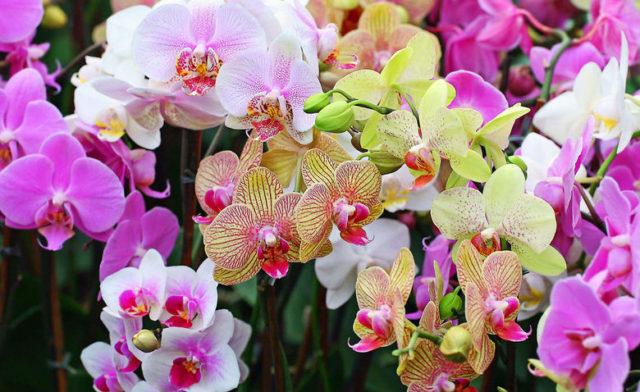

But you can also use the alternation of modes:
- In the morning and in the evening, the red spectrum is used, in the afternoon - the blue. Daylight is injected for a couple of hours twice a day.
- Introducing two kinds of lighting at the same time. Daylight is again introduced as an hour's supplement in the morning and evening.
Violets
The development and flowering of violets stops when there is a lack of lighting. Therefore, the introduction of additional light sources is required.
An excellent option would be a phytolamp with an LED strip. In this case, the spectrum should contain a cold shade, the power per meter is 25 watts.
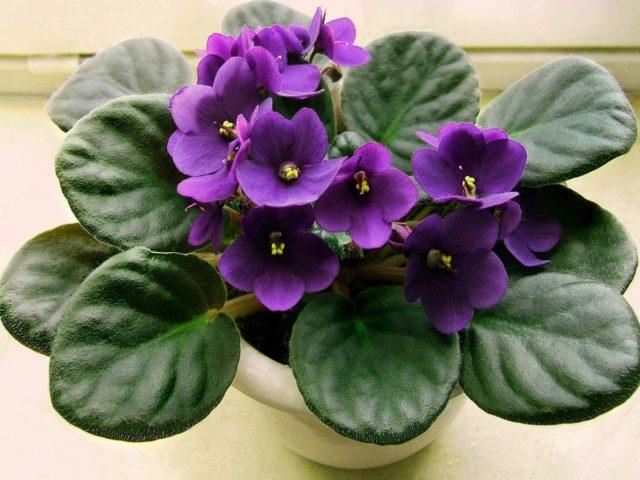

The backlight is used only on cloudy days or when there is no sunlight at all.
Violet needs lighting up to 14 hours, so on short light days, the lights are turned on for a couple of hours before sunset.
You can also use a phytolamp with a fluorescent lamp. This is suitable for shelves with flowers far from the window.
Petunias
Additional lighting is required in order for the sprouts to have a strong structure and to reproduce.
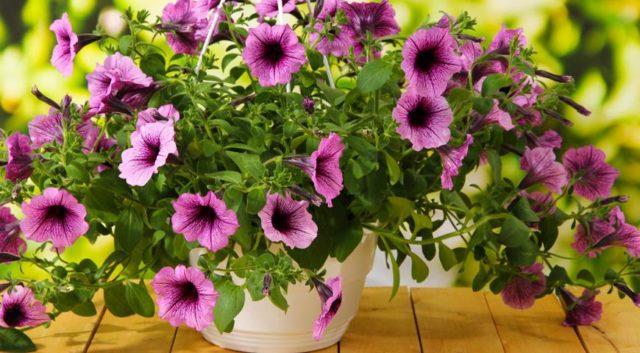

Small sprouts are sufficient to grow on a windowsill in natural daylight or use reflectors.
For more mature flowers, use a compact fluorescent lamp or a standard draw-out lamp.
Cactus
Cacti are very demanding on light. They should be located in the southern part of the house, where the sun's rays constantly penetrate through the window.
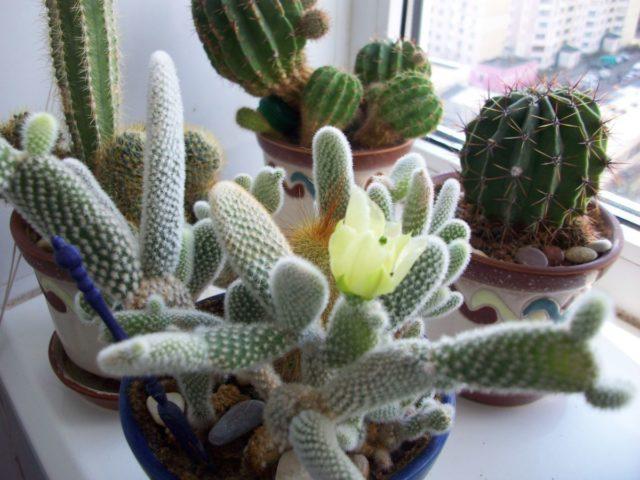

There are situations when the side in the apartment is not south, but you want to grow such a plant. Then the owners resort to an additional light source. The blue spectrum is needed for the growth and development of the root system, the orange-red for flowering and branching. Such lighting is provided by LED or fluorescent phytolamps.
Review of the best models
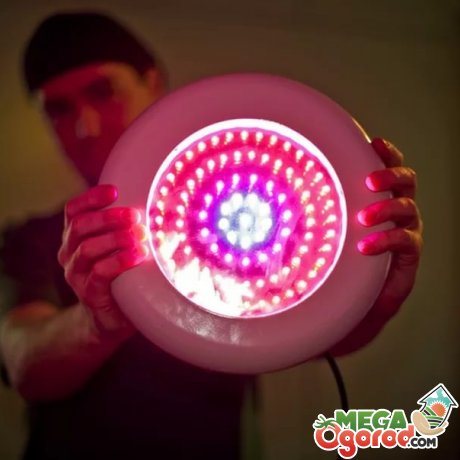

Phytolamp production does not stand still. New and improved models appear. Among the well-known companies involved in the production of phytolamps are Paulmann, Secret Jardin, Philips, LED. Many models are offered by Chinese manufacturers. The light sources they produce are reliable and last a long time.
Among Russian companies, LED lamps are produced by Fitosvet, Focus LLC, Ecolight. The devices of the companies can be equipped with greenhouses, installed in greenhouses. In addition to providing high-quality illumination, such devices create an optimal indoor microclimate.
Flower lamp manufacturers take care of increasing the power of their appliances. So now they produce lamps with a capacity of up to five watts, and complex lamps - up to 10-30. Phytolamps can be purchased in specialized stores or ordered on the websites of manufacturers of lighting devices.
When choosing a lamp model for their green pets, they rely on the number of plants that need high-quality lighting.
Among the popular devices for improving the illumination of plants on racks and windowsills is the Grow Panel. It contains LEDs of the blue and red spectrum in the same quantity. The luminaire is lightweight and reliable, it is hung over flowers located on an area of ten square meters. The panel has convenient fasteners, plugs into a 220 Volt socket.
To illuminate plants on an area of 0.4 square meters, Economy LED lamps with a power of 2-4 watts are suitable. It is convenient to place them above the pots of indoor plants. Containers with flowers on a windowsill or shelf are illuminated with a linear lamp a meter or more long. A MegaLux device with a power of 14-16 watts will last a long time. Having installed it over the plants in winter, they will receive indoor flowers, strong, well-developing. They note the long service life of the lighting device, its safety and reliability.
Driver calculation and base selection
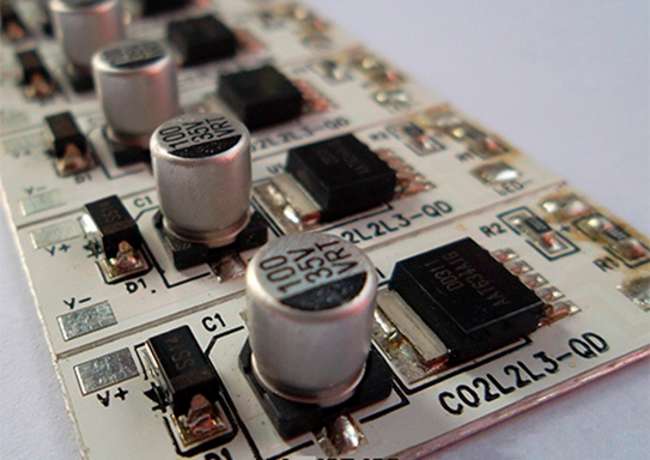

Linear LED Driver
The power supply is an obligatory part of the lamp. It equalizes the output voltage and supplies the LEDs with optimal power.
The documentation for the tape indicates the value of the voltage drop at different amperage values. This value must be multiplied by the number of diodes. The optimal number of drivers is selected from the obtained parameter.
Recommendations to help with installation and connection:
- The best driver option is 50W. More powerful devices will heat up and cost more. In terms of current strength, the optimal choice of a 600 mA source.
- When calculating the driver, you should take into account the real, not the maximum power of the LEDs. It is calculated as the current of the source used multiplied by the voltage drop.
Special attention should be paid to the choice of the driver. Without this element, the normal operation of the phytolamp is impossible.
Any material can be used as the lamp surface. Phytolamps are often made of plywood, boards, but in this case it is imperative to think over the cooling system. Better to take aluminum - then the heat will be removed from the surface and the device will last longer.
You can buy an aluminum decorative strip at any hardware store. For fastening, holes are made in the corners of the base, for which you can hang the structure.
Real reviews
“I decided to experiment with LED lamps. Unexpectedly, but the result is pleasing. Lettuce and parsley really reach for the lamp, even when the sun is shining! "
Kristina
“I bought a phytolamp Sidor 5 years ago. I'm still not overjoyed. It does not heat up, does not flicker, consumes less than 18W, but perfectly and very effectively illuminates the entire balcony. Highly recommend."
Evgeny
“I thought for a very long time before purchasing an LED plant lamp Volia“ Fitosvet-D ”. Red and blue diodes, it is unclear whether it will be useful, and a little expensive! But he took it, and did not regret it. The result is great, the growth rate of greens and seedlings has increased, and they themselves are fatter. So there is a sense! "
![]()
![]()
I got acquainted with phytolamps about 6 years ago, when I bought the first fluorescent lamp at a rather high price - 400 rubles. Alas, I never saw the effect of it. As I understood, such lamps last from 3 to 6 months, and then they seem to "burn out" and do not give an effect. Then there was an aquarium phytolamp with a pink glow, but it also did not cope with the task.
In the fall of 2019, we moved to our house. Joy was overshadowed by one thing: the largest windows overlooked the north side, and although the orchid blooms on it without ceasing, there would not be enough light for seedlings. And in winter, another problem became clear: all the windows, especially the only south-facing window, were very cold, the plastic was literally covered with ice. Growing seedlings in such conditions was unrealistic. Therefore, I immediately told my husband - you need to buy a phytolamp and set a table for seedlings. And she began to choose a new generation of lamps: LED.
My seedlings in April 2019
Application
It should be noted that phytolamp for seedlings requires proper handling. What needs to be considered for this?
- If you bought one of the types of lamps that glow significantly during operation, keep in mind that they need to be located at a sufficient distance. Otherwise, kill your "pets".
- Area! The size of the space you need to illuminate plays one of the key roles in the selection of the device. Several "luminaries" are often required. The calculation is as follows: one square of area requires seventy watts.
- I put it and forgot it. This is not your motto in this case. It will be necessary to monitor the cleanliness of the unit, as well as to ensure that moisture does not get into it.
- If the lamp device is still, this is not bad at all. This feature will allow you to repair the device in the future.
Remember that each type of greenery needs its own strength and type of light. So, representatives of the flora are:
- Lovers of the shade.Such supporters of muted light will get away with devices with a wavelength of light radiation of 400 nanometers.
- Calmly bearing the shadow. For them, select an apparatus with parameters for thirty nanometers more.
- Adherents of diffused light. This requires a wavelength of 660 nanometers.
- If greens love light, then choose those that give out 730 nanometers.
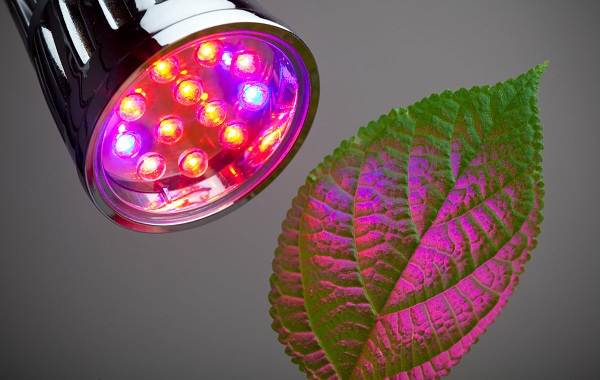

As a rule, the best combination is blue, red and colorless (white) rays. If all these varieties are included in the kit of one lamp, it will be a good purchase.
If you want to diffuse light, install a matte screen. If, on the contrary, you need to enhance the glow, then prepare a mirror reflector.
The beams should hit from above towards the bottom, and not vice versa. This position of the lamp will provide the closest to natural lighting. It will be ideal if the device is placed at a distance of about thirty centimeters from seedlings, or flowers.
Reflectors help direct the light flux in the right direction. If such an add-on is not included in the kit, for example, with a luminescent installation, then you will experience large losses of light, because it will simply fly away anywhere.
Suspension height of phyto-luminaire
We decided on the form and power, and at what height should we hang the whole thing?


In LED models, a lot depends on the angle of their glow. For LEDs, it is 120 degrees.
At the same time, with the propagation of light from phytolamps, the light beam is divided into:
- efficient (the one closer to the LED)
- and less efficient light


So, initially, the height of the phytolamp suspension should be determined based on the height of the plant itself.
The phyto-lamp should be positioned in such a way that there is about 25-30 cm between the LED and the top of the greenery.
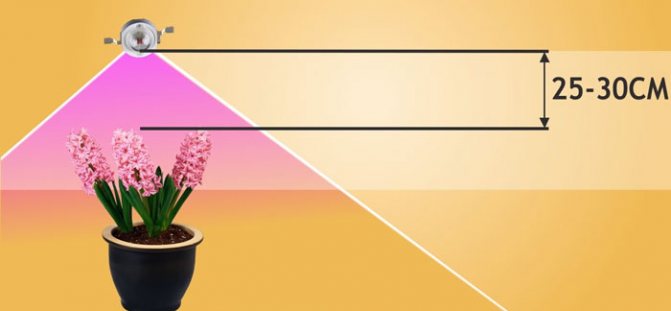

Naturally, all plants gradually grow, which means that the lamp will have to be raised higher and higher in order to preserve these most cherished centimeters.


Note, however, that there is a slight difference in the recommended height for different greenery. For example, for seedlings it is 20-25cm.
But for adult flowers - already 25-30cm.
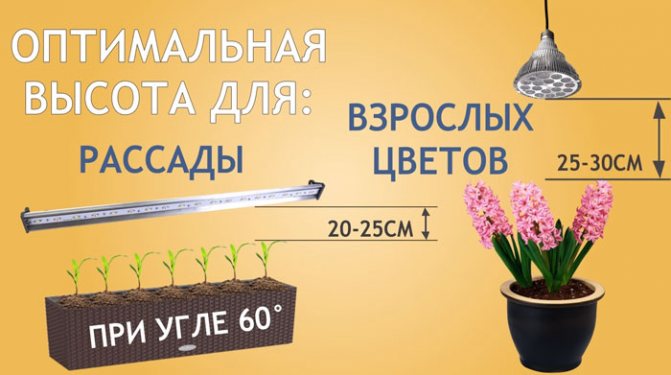

It seems to be not so important, but in the end all this affects their growth.
Also worth mentioning is one unpleasant effect. The zone of effective light moves further and further from the base of the plant with each rise of the lamp.
To somehow compensate for this, use a lens.
Checking the LEDs with a tester
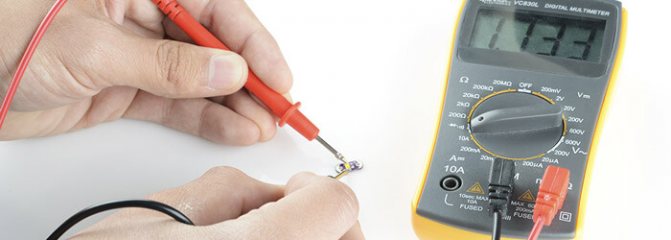

Checking the LED with a multimeter
You can determine the performance of LEDs for phytolamps using a tester. The verification algorithm is as follows:
- Installing the tester in the “open test” position.
- Touch the leads with the probe. Red is placed on the anode, black - on the cathode.
- When checking, the diodes should light up. Defective ones will not shine.
- When the polarity is reversed, the display should remain one.
Also, testing on a multitester can be carried out through the sockets for transistors. The holes on the left of the anode are placed in sockets E, the cathodes - in C. For the holes on the right, vice versa.
Why is the impact on the human body dangerous?
Flashing backlights have a negative effect on human health, no matter how long they have been under UV rays. It acts on:
- the nervous system and photoreceptor elements of the retina in adolescents;
- vision, concentration.
Devices containing mercury worsen the condition of patients who are already ill. Being near the phytolamp, skin diseases caused by ultraviolet light are renewed. Everyone's reaction to it is different: it may not appear at all or appear 15 minutes after being near the device.
We advise you to watch the video:

